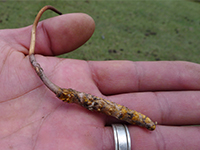
Himalayan Viagra Sparks Gold Rush for Medicinal Fungus

Finding a single spore of the fungus could yield the cash equivalent of what local men typically make over several days carrying a heavy backpack of goods across mountain passes.
Overwhelmed by speculators trying to cash-in on a prized medicinal fungus known as Himalayan Viagra, two isolated Tibetan communities have managed to do at the local level what world leaders often fail to do on a global scale — implement a successful system for the sustainable harvest of a precious natural resource, suggests new research from Washington University in St. Louis.
“There’s this mistaken notion that indigenous people are incapable of solving complicated problems on their own, but these communities show that people can be incredibly resourceful when it’s necessary to preserve their livelihoods,” said study co-author Geoff Childs, PhD, associate professor of anthropology in Arts & Sciences.
Writing in the current issue of the journal Himalaya, Childs and Washington University anthropology graduate student Namgyal Choedup describe an innovative community resource management plan that some conservative capitalists might view as their worst regulatory nightmare.
In one remote village, for weeks in advance of the community-regulated harvest season, all able-bodied residents are required to show their faces at a mandatory roll call held four-times daily to ensure that no one is sneaking off into the nearby pastures to illegally harvest the precious fungus.
While regulations such as these might seem overly authoritarian, they’ve been welcomed by community residents desperate to get a grip on chaos associated with feverish demand for yartsa gunbu, a naturally-occurring “caterpillar fungus” prized in China for reported medical benefits. Use of the fungus as an aphrodisiac has earned it the nickname Himalayan Viagra.
View 20-image slideshow: https://news.wustl.edu/news/Pages/27447.aspx
Yartsa gunbu (literally ‘summer grass, winter worm’; Ophiocordyceps sinensis) results from a fungal infection that invades the bodies of ground-burrowing ghost moth caterpillars. In early spring, pinky-sized spores of the fungus emerge from the caterpillars’ mummified bodies and pop up in remote grassland pastures across the Tibetan Plateau.
Located high in the Himalayan foothills along Nepal’s northern Gorkha District border with China’s Tibet Autonomous Region (TAR), the tiny rural communities of Nubri and Tsum have been ignored by economic developers for decades — schools, roads and medical facilities are few and far between. Residents have long had little access to cash, with most scraping by on meager incomes from farming, grazing, timber sales and odd jobs.
With yartsa gunbu fetching more per ounce than gold in some Chinese markets, many villagers now reap as much as 80 percent of their annual income during the caterpillar fungus spring harvest season.
Although local incomes are still modest by Western standards, residents have seen average annual incomes rise from an average of a few hundred dollars to upwards of $4,000. But along with these riches has come serious concerns about the impact of money and outsiders on local traditions and the fragile alpine environment in which yartsa gunba thrives.
Recent news coverage has focused on community tensions and infighting over harvesting practices, the flood of outsiders seeking to take part in the harvest and allegations of graft and bribery among community leaders.
In June 2014, a clash with police left two dead in a dispute between members of the local community and a National Park Buffer Zone Management Committee over who has the right to collect and keep fees paid by outsiders for access to yartsa gunbu grounds. Two more people died in a 2013 fight between Tibetan groups near Rebgong, China.
Meanwhile, outside experts warn that over-harvest of the fungus could cause irreparable damage to fragile high-mountain pastures, with some suggesting yartsa gunba production already had declined by 40 percent.
Despite dire predictions, research by Childs and Choedup suggests that local communities are rising to the challenge. Their study documents how the residents of Tsum and Nubri have built on existing religious and cultural traditions to devise incredibly cooperative and creative systems to self-manage and regulate the community’s annual fungus harvest.
The communities’ harvest protocols, they argue, represent an indigenous form of regulatory management, one that may prove sustainable and equitable over the long-term.
Grounded in the resident’s traditional rights to use surrounding pasturelands for grazing and other purposes, the yartsa gunba management plans strive to manage the resource wisely while affording all residents a fair chance to share in the bounty.
Key components of the plans include:
* Restricting yartsa gunbu harvest to members of local households regardless of where they currently reside.
* Sizeable penalties for those caught harvesting outside of the community-enforced season; preseason roll calls require able-bodied residents to check in at local meeting house four times daily (7 a.m., 10 a.m., 2 p.m. and 6 p.m.)
* Requiring harvesters to register with their local villages and pay a small tax to finance projects that support the harvest.
* Prohibiting yartsa gunbu harvest on mountain slopes long considered sacred, thus establishing conservation sanctuaries that will help preserve fungus breeding populations.
Childs and Choedup’s research documents a rise in social concerns associated with the sudden rise in incomes, but also finds many positive impacts on the lives of local residents.
The harvest provides an opportunity for people to improve their standard of living, start business ventures, enhance religious life, provide better education for children, and mitigate the economic burden associated with deaths in the family — improvements that have been made without the help of state-sponsored development initiatives, they argue.
“In the case of Nubri and Tsum, management practices that were devised independent of state interference may prove to be sustainable over the long-run,” Childs said. “Although many observers have called for more government intervention in the harvesting and sale of yartsa gunbu, our research demonstrates that, at least in some communities, it is better to allow locals to manage the resource and reap the benefits on their own terms.”
Contact Information
Gerry Everding
Executive Director, Digital News
gerry_everding@wustl.edu
Phone: 314-935-6375












